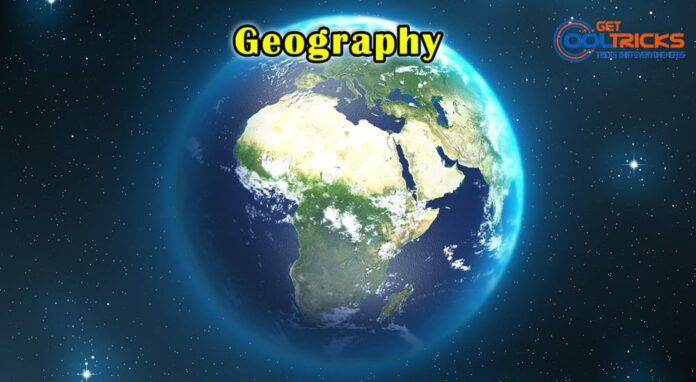An atmosphere is more likely to be retained if the gravity it is subject to is high and the temperature of the atmosphere is low.
Earth Atmosphere
- Nitrogen (about 78%) – nitrogen is fixed by bacteria and lightning to produce ammonia used in the construction of nucleotides.
- Oxygen (about 21%) – Oxygen is used by most organisms for respiration
- Argon (about 0.9%)
- Carbon dioxide, Methane, Rare (inert) gases(about 0.1%)
Layers of the Atmosphere
The atmosphere is composed of discrete layers. Atoms and molecules travel rapidly within a layer but only very slowly between layers. The layering results from temperature variations of the gas molecules.
- Troposphere
- Stratosphere
- Mesosphere
- Thermosphere
- Exosphere
- Ionosphere
1. Troposphere
- The troposphere is the lowest layer of our atmosphere.
- Starting at ground level, it extends upward to about 10 km (6.2 miles or about 33,000 feet) above sea level.
- We humans live in the troposphere, and nearly all weather occurs in this lowest layer.
- The standard lapse rate for the troposphere is a decrease of about 6.5 degrees Celsius (C) per kilometer (km) (or about 12 degrees F).
- Near the surface, the lapse rate changes dramatically from hour to hour on clear days and nights.
- Sometimes the temperature does not decrease with height, but increases. Such a situation is known as a temperature inversion.
- Most clouds appear here, mainly because 99% of the water vapor in the atmosphere is found in the troposphere.
- Air pressure drops, and temperatures get colder, as you climb higher in the troposphere
2. Stratosphere
- The next layer up is called the
- The stratosphere extends from the top of the troposphere to about 50 km (31 miles) above the ground.
- The infamous ozone layer is found within the stratosphere.
- The standard inverse lapse rate for the Stratosphere is about 6.5 degrees Celsius (C) per kilometer (km) (or about 12 degrees F).
- Ozone molecules in this layer absorb high-energy ultraviolet (UV) light from the Sun, converting the UV energy into heat.
- Unlike the troposphere, the stratosphere actually gets warmer the higher you go.That trend of rising temperatures with altitude means that air in the stratosphere lacks the turbulence and updrafts of the troposphere beneath.
- Commercial passenger jets fly in the lower stratosphere, partly because this less-turbulent layer provides a smoother ride.
- The jet stream flows near the border between the troposphere and the stratosphere.
3. Mesosphere
- Above the stratosphere is the mesosphere.
- It extends upward to a height of about 85 km (53 miles) above our planet.
- Most meteors burn up in the mesosphere.
- Unlike the stratosphere, temperatures once again grow colder as you rise up through the mesosphere.
- The coldest temperatures in Earth’s atmosphere, about –90° C (-130° F), are found near the top of this layer.
- The air in the mesosphere is far too thin to breathe; air pressure at the bottom of the layer is well below 1% of the pressure at sea level, and continues dropping as you go higher.
4. Thermosphere
- The layer of very rare air above the mesosphere is called the
- High-energy X-rays and UV radiation from the Sun are absorbed in the thermosphere, raising its temperature to hundreds or at times thousands of degrees.
- However, the air in this layer is so thin that it would feel freezing cold to us. In many ways, the thermosphere is more like outer space than a part of the atmosphere.
- Many satellites actually orbit Earth within the thermosphere.
- Variations in the amount of energy coming from the Sun exert a powerful influence on both the height of the top of this layer and the temperature within it.
- Because of this, the top of the thermosphere can be found anywhere between 500 and 1,000 km (311 to 621 miles) above the ground.
- Temperatures in the upper thermosphere can range from about 500° C (932° F) to 2,000° C (3,632° F) or higher. The aurora, the Northern Lights and Southern Lights, occur in the thermosphere.
5. Exosphere
- Although some experts consider the thermosphere to be the uppermost layer of our atmosphere, others consider the exosphere to be the actual “final frontier” of Earth’s gaseous envelope.
- As you might imagine, the “air” in the exosphere is very, very, very thin, making this layer even more space-like than the thermosphere.
- In fact, air in the exosphere is constantly – though very gradually – “leaking” out of Earth’s atmosphere into outer space.
- There is no clear-cut upper boundary where the exosphere finally fades away into space. Different definitions place the top of the exosphere somewhere between 100,000 km (62,000 miles) and 190,000 km (120,000 miles) above the surface of Earth. The latter value is about halfway to the Moon.
6. Ionosphere
- The ionosphere is not a distinct layer like the others mentioned above.
- Instead, the ionosphere is a series of regions in parts of the mesosphere and thermosphere where high-energy radiation from the Sun has knocked electrons loose from their parent atoms and molecules.
- The electrically charged atoms and molecules that are formed in this way are called ions, giving the ionosphere its name and endowing this region with some special properties.


